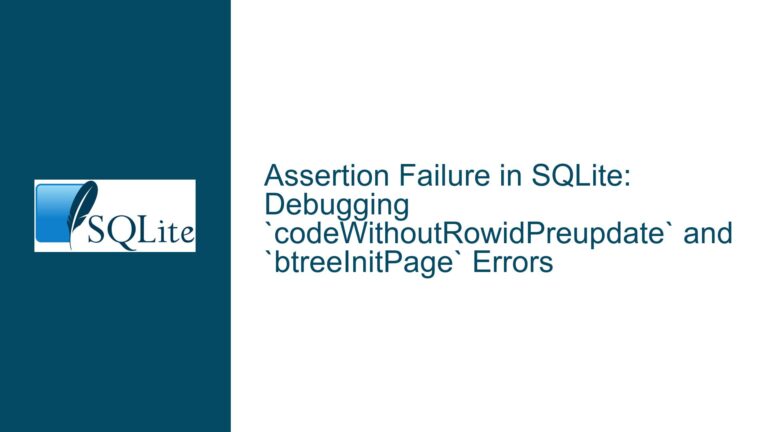Resolving Virtual Table xShadowName Context Limitations in SQLite Bindings
Virtual Table xShadowName Context Limitations and Dynamic Language Bindings
Issue Overview: Missing Context in xShadowName for Virtual Table Implementations
The SQLite virtual table API provides the xShadowName method as part of the sqlite3_module structure. This method is critical for identifying shadow tables associated with a virtual table. Shadow tables are internal structures used by virtual tables to store metadata or auxiliary data. However, the xShadowName method is passed only a const char* parameter representing the candidate shadow table name suffix. Unlike other methods in the sqlite3_module (e.g., xCreate, xConnect), xShadowName does not receive a sqlite3_vtab* pointer or the pClientData registered via sqlite3_create_module_v2.
This design creates significant challenges for dynamic language bindings (e.g., Python, Go, Perl) where virtual table implementations are often stateful and rely on context-specific data. For example, a Python module wrapping SQLite may need to map xShadowName calls to the correct virtual table instance or module registration. Without access to the sqlite3_vtab* or pClientData, developers cannot directly associate the xShadowName invocation with the corresponding module configuration.
The problem is exacerbated in multi-module environments where multiple virtual table implementations coexist. A single xShadowName function cannot reliably determine which module’s shadow tables it is validating without additional context. This forces developers to implement fragile workarounds, such as static mappings, global state tracking, or redundant callback functions, which introduce complexity and potential race conditions.
Key symptoms of this issue include:
- Inability to dynamically associate shadow table names with their parent virtual table modules.
- Reliance on global variables or thread-local storage to track module context.
- Arbitrary limits on the number of virtual table modules due to manual slot management.
- Increased risk of shadow table name collisions across modules.
Possible Causes: SQLite API Constraints and Dynamic Language Integration
The absence of context in xShadowName stems from SQLite’s architectural decisions and the method’s role in schema validation:
Pre-Connection Validation:
ThexShadowNamemethod is invoked during schema operations (e.g.,CREATE TABLE) before the virtual table’sxCreateorxConnectmethods are called. At this stage, SQLite has not yet instantiated thesqlite3_vtabstructure, making it impossible to pass a valid pointer.Module Agnosticism:
SQLite treatsxShadowNameas a stateless validator. Its sole purpose is to answer the question: “Is this table name a shadow table reserved by any virtual table module?” This agnosticism allows SQLite to enforce shadow table isolation without requiring internal knowledge of module-specific data structures.Client Data Isolation:
ThepClientDatapointer registered withsqlite3_create_module_v2is only propagated toxCreateandxConnect. SincexShadowNameoperates outside the lifecycle of a specific virtual table instance, it cannot access this data without violating encapsulation.Dynamic Language Binding Limitations:
Language bindings like APSW (Python) orgo-sqlite3(Go) face unique challenges because they must bridge SQLite’s C API with language-native abstractions. These bindings often generatesqlite3_modulestructures dynamically, and the lack of context inxShadowNameforces them to rely on brittle workarounds (e.g., function address tracking) to map calls to the correct module.Thread Safety and Concurrency:
Global state tracking (e.g., using a registry of module contexts) introduces concurrency risks in multi-threaded environments. Without atomic operations or mutex guards, concurrent schema modifications could corrupt the registry.
Troubleshooting Steps, Solutions & Fixes: Contextualizing xShadowName
Solution 1: Indexed xShadowName Callbacks with Static Slot Allocation
This approach involves creating multiple xShadowName callback functions, each associated with a unique index. The index is used to look up module-specific context data stored in a global registry.
Implementation Steps:
Define a Fixed Number of Slots:
Allocate a static array to hold module context pointers. For example:#define MAX_MODULES 32 static void* g_module_contexts[MAX_MODULES]; static pthread_mutex_t g_context_mutex = PTHREAD_MUTEX_INITIALIZER;Generate Indexed Callbacks:
Use code generation or macros to createxShadowNamefunctions for each slot:#define XSHADOWNAME_DEF(n) \ int xShadowName_##n(const char* suffix) { \ return handle_xShadowName(n, suffix); \ } XSHADOWNAME_DEF(0) XSHADOWNAME_DEF(1) // ... up to MAX_MODULESSlot Management:
Implement functions to acquire and release slots:int acquire_module_slot(void* context) { pthread_mutex_lock(&g_context_mutex); for (int i = 0; i < MAX_MODULES; i++) { if (g_module_contexts[i] == NULL) { g_module_contexts[i] = context; pthread_mutex_unlock(&g_context_mutex); return i; } } pthread_mutex_unlock(&g_context_mutex); return -1; // No slots available }Context-Aware Handler:
Route the indexed callback to the module-specific logic:int handle_xShadowName(int slot, const char* suffix) { void* context = g_module_contexts[slot]; // Delegate to language-specific logic using 'context' return my_module_xShadowName(context, suffix); }
Advantages:
- Avoids global state corruption via slot-based isolation.
- Thread-safe with proper mutex guards.
Limitations:
- Arbitrary slot limit requires recompilation to adjust.
- Increased binary size due to multiple callback functions.
Solution 2: Single Callback with Reserved Prefix
If the virtual table module can enforce a naming convention for shadow tables, a single xShadowName callback can return 1 (reserved) for all names matching a predefined prefix.
Implementation Steps:
Define a Prefix:
Document that the module reserves all table names starting with a specific prefix (e.g.,mumble_).Universal Callback:
int xShadowName_universal(const char* suffix) { return strncmp(suffix, "mumble_", 7) == 0; }Module Initialization:
Ensure all virtual tables created by the module adhere to the prefix:static int xCreate(sqlite3* db, void* pAux, int argc, const char* const* argv, sqlite3_vtab** ppVTab, char** pzErr) { const char* vtname = argv[2]; if (!strstr(vtname, "mumble")) { *pzErr = sqlite3_mprintf("Table name must start with 'mumble'"); return SQLITE_ERROR; } // Proceed with creation }
Advantages:
- Eliminates the need for context tracking.
- Simplifies implementation by shifting responsibility to the user.
Limitations:
- Inflexible naming conventions may conflict with user requirements.
- Does not scale to modules with dynamic shadow table patterns.
Solution 3: Defer xShadowName Implementation
If shadow table validation is not critical for the use case, defer implementing xShadowName until explicitly required by users.
Implementation Steps:
Omit xShadowName in sqlite3_module:
static sqlite3_module my_module = { .xCreate = xCreate, .xConnect = xConnect, // ... other methods .xShadowName = NULL // Omitted };Document the Limitation:
Clearly state that the module does not protect shadow tables, and users must avoid naming conflicts manually.
Advantages:
- Reduces implementation complexity.
- Avoids performance overhead from context tracking.
Limitations:
- Risks data corruption if users accidentally create conflicting tables.
- Limits the module’s usability in multi-tenant environments.
Solution 4: Hybrid Approach with Dynamic Suffix Registration
For modules that dynamically generate shadow table suffixes, maintain a global registry of reserved suffixes.
Implementation Steps:
Suffix Registration API:
static pthread_mutex_t g_suffix_mutex = PTHREAD_MUTEX_INITIALIZER; static char** g_reserved_suffixes = NULL; static int g_num_suffixes = 0; void register_shadow_suffix(const char* suffix) { pthread_mutex_lock(&g_suffix_mutex); g_reserved_suffixes = realloc(g_reserved_suffixes, (g_num_suffixes + 1) * sizeof(char*)); g_reserved_suffixes[g_num_suffixes++] = strdup(suffix); pthread_mutex_unlock(&g_suffix_mutex); }Universal xShadowName Check:
int xShadowName_hybrid(const char* suffix) { pthread_mutex_lock(&g_suffix_mutex); for (int i = 0; i < g_num_suffixes; i++) { if (strcmp(suffix, g_reserved_suffixes[i]) == 0) { pthread_mutex_unlock(&g_suffix_mutex); return 1; } } pthread_mutex_unlock(&g_suffix_mutex); return 0; }
Advantages:
- Allows dynamic suffix management.
- Centralized registry simplifies conflict checks.
Limitations:
- Requires synchronization for thread safety.
- Adds runtime overhead for suffix lookups.
Conclusion
The absence of contextual data in SQLite’s xShadowName callback necessitates creative workarounds for dynamic language bindings and stateful virtual table modules. Developers must choose between slot-based indexing (for precise context tracking), prefix reservation (for simplicity), or deferred implementation (for minimalism). Each approach involves trade-offs in complexity, flexibility, and thread safety. Until SQLite extends the xShadowName API to include pClientData or a module identifier, these solutions provide pragmatic pathways to robust virtual table implementations.






